 It’s February 29, 2008. What does this “Leap Day” mean to you? For conservationists and amphibian-lovers, it’s the launch date for the Year of the Frog, a reminder that, since 1980, “at least 120 species of frogs, toads, salamanders and other amphibians have gone extinct; as many as half of the 6,000 remaining species may soon vanish unless immediate action is taken. ” (see “Leap Day: Doomesday Vault for Frogs“)
It’s February 29, 2008. What does this “Leap Day” mean to you? For conservationists and amphibian-lovers, it’s the launch date for the Year of the Frog, a reminder that, since 1980, “at least 120 species of frogs, toads, salamanders and other amphibians have gone extinct; as many as half of the 6,000 remaining species may soon vanish unless immediate action is taken. ” (see “Leap Day: Doomesday Vault for Frogs“)
Leap Day —
the space where
a frog was……………. by laryalee fraser
– borrowed, as amended, from this haiga –
- For loophole-loving lawyers over the centuries, it’s “not a real day and had no status in English law” (Sydney Morning Herald, Feb. 28, 2004) — fertile ground indeed for the creative defense lawyer or crafty draftsman.
- For math and astronomy wonks, it’s an opportunity to explain again ad nauseum that “our solar year is 365.24219 days,” with all the resultant need for intercalary machinations and refinements.
- For the Chamber of Commerce of Anthony, Texas, it’s a chance to attract a crowd of Leap Year Babies (“leapings”) to their “6th Worldwide Leap Year Festival,” at the self-proclaimed Leap Year Capital of the World. [And see, “Local ‘29ers’ celebrate rare leap year birthdays,” Schenectady Daily Gazette, Feb. 29, 2008]
 More to the point, for lonely ladies (or their impatient fathers) tired of waiting on that prince or other “fellas-ta-come-a-courtin,” and for their selective-but-traditionalist sisters impatient for Mr. Right to do the asking, “Leap Day is for (unconventional) lovers” — the one day when a woman could with society’s blessing propose to any man of her choosing. (see The Daily Green, Feb. 26, 2008) As the folks at Time & Date.com explain about February 29th:
More to the point, for lonely ladies (or their impatient fathers) tired of waiting on that prince or other “fellas-ta-come-a-courtin,” and for their selective-but-traditionalist sisters impatient for Mr. Right to do the asking, “Leap Day is for (unconventional) lovers” — the one day when a woman could with society’s blessing propose to any man of her choosing. (see The Daily Green, Feb. 26, 2008) As the folks at Time & Date.com explain about February 29th:
Tradition, Folklore and Superstition
A tradition was introduced many centuries ago to allow women to propose to men during a leap year. This privilege of proposing was restricted to leap day in some areas. Leap day was sometimes known as “Bachelors’ Day”. A man was expected to pay a penalty, such as a gown or money, if he refused a marriage offer from a woman.
The tradition’s origin stemmed from an old Irish tale referring to St Bridget striking a deal with St Patrick . . .
running
right past me —
ms. sadie hawkins………. by dagosan
For more particulars, see Wikipedia‘s discussion of Leap Year traditions, and check out Denis Kitchen’s description of Sadie Hawkins’ Day, on which all unmarried women could chase down Dogpatch bachelors and hogtie them into marriage. Although Al Capp always held the Sadie Hawkins Race in early November, in his Li’l Abner comic strip, it is now celebrated on (or confused with) February 29th by many Americans. Al Capp is gone, but unmarried women needing a little incentive, might want to check our the article “Hotels offer Leap Day proposal specials“(The Indy Star, Feb. 10, 2008).
“Be careful, Clara, that’s a fine Specimen.” (Leap Year postcard, 1908)
one gray moth
above the candle –
Leap Day ends……. by dagosan
leap year day
she goes down
on one knee
………………. by roberta beary
 Naturally, the Leap Day tradition is also a boon or slight beacon of hope (and often a disappointment) for bashful bachelors, and those suffering chronically unrequited love (like this one, whose still in search of an Attractive Nuisance co-blogger). Of course, many such single guys have always been just too darn choosey, and I’m sure they’ve been lining up excuses just in case they need to say no to a Leap Day proposal. As noted above, any such rejection is subject to penalties. According to Wikipedia:
Naturally, the Leap Day tradition is also a boon or slight beacon of hope (and often a disappointment) for bashful bachelors, and those suffering chronically unrequited love (like this one, whose still in search of an Attractive Nuisance co-blogger). Of course, many such single guys have always been just too darn choosey, and I’m sure they’ve been lining up excuses just in case they need to say no to a Leap Day proposal. As noted above, any such rejection is subject to penalties. According to Wikipedia:
“Supposedly, a 1288 law by Queen Margaret of Scotland (then age five and living in Norway), required that fines be levied if a marriage proposal was refused by the man; compensation ranged from a kiss to £1 to a silk gown, in order to soften the blow.”
Let’s hope the fines will not be needed, and Leap Day brings happiness to members of both genders. Our ever-optimistic haikuEsq wrote rather late last night to a number of female haijin, pleading for them to submit a haiku or senryu to share here today in honor of Leap Day. You’ll find poems sprinkled throughout this post from a number of those fair ladies, along with a few plaintive ones by our sadsack dagosan. Many thanks to Alice, Roberta, and Laryalee.
As we receive (or conceive of) more Leap Day Ku, we’ll add them to this posting. Meanwhile, you single folk shouldn’t let Leap Day slip by without letting the (unmarried) object of your affections know your feelings.
together . . . 
first light
of the extra day
…………. by alice frampton
the frog
and the lady –
eyeing that mosquito………. by dagosan
leaping into
the sound of no —
frog prince
………………….. by laryalee fraser
he tells her
he’s already married
…leap year day………………. by roberta beary
almost March 1st
the Leap Day Bachelor
re-checks his email…………. by dagosan
afterglow (4 PM):
the short month
a leap day longer–
he says yeslunch date
I dare him to mention
Sadie Hawkins’ Day……………………. by peggy willis lyles
aftermath (March 1, 2008):
leap day
the peach tones
of her nakedness………… by Ed Markowski
March 1st snow —
the old horny toad
wakes alone…………….. by dagosan
much more than an afterthought (March 3, 2008):
Leap Day –
an old friend
takes off her glasses……….. by Yu Chang – photo haiga orig. posted at Magnapoets JF (March 2, 2008)
– update (March 3, 2008): Thanks to our friend David Fischer at Antitrust Review for including this posting in Blawg Review #149, which contains an extensive compilation of the best recent antitrust-&-competition-related materials, as well as everything else of merit, to be found in the blawgiverse. We are pleased that our open rivalry with Antitrust Review for top Google ratings relating to “antitrust humor and sexiness” did not prevent David from pointing to our Leap Day presentation. We’re a little concerned, though, that he placed this very serious piece of sociology and advocacy in the category “The Lighter Side”.
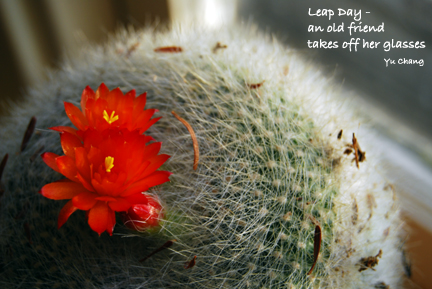


 Four authors are quoted on the dust-jacket of An Almost Life, and have spot-on remarks. Andrew Neiderman, who wrote
Four authors are quoted on the dust-jacket of An Almost Life, and have spot-on remarks. Andrew Neiderman, who wrote  A Novel for Just About Everybody. So, who do I think would benefit from An Almost Life? Just about every adult with a sense or humor and justice, and five or six hours to devote to the pleasures of a fine first novel. Read it for the sheer entertainment; for its insights into middle-aging, or finding yourself, your mate, or your place in the world; or (whether you’re a non-lawyer or an attorney looking in from another part of the profession) to get a realistic impression of the job and the role of a personal injury lawyer who is in it for more than the money and glory. I’m glad I got to meet Mike Samuels and — since he works right down the road — hope to meet his creator, before Kevin Mednick flees to that lovely land where successful lawyer-novelists dwell.
A Novel for Just About Everybody. So, who do I think would benefit from An Almost Life? Just about every adult with a sense or humor and justice, and five or six hours to devote to the pleasures of a fine first novel. Read it for the sheer entertainment; for its insights into middle-aging, or finding yourself, your mate, or your place in the world; or (whether you’re a non-lawyer or an attorney looking in from another part of the profession) to get a realistic impression of the job and the role of a personal injury lawyer who is in it for more than the money and glory. I’m glad I got to meet Mike Samuels and — since he works right down the road — hope to meet his creator, before Kevin Mednick flees to that lovely land where successful lawyer-novelists dwell.




 “He’s Road Chill” – or, the long-simmering, soul-numbing vengeance evidenced on January 11, 2008, in
“He’s Road Chill” – or, the long-simmering, soul-numbing vengeance evidenced on January 11, 2008, in  – and, the all-consuming malevolent presence in the upcoming movie
– and, the all-consuming malevolent presence in the upcoming movie  –
– Denial/Delusion: The USA Weekend article on snowmen (“
Denial/Delusion: The USA Weekend article on snowmen (“ Yes, I’m appalled (and a little ashamed), too. For your information, Stewart’s Pandemonium is a lot like Perry’s
Yes, I’m appalled (and a little ashamed), too. For your information, Stewart’s Pandemonium is a lot like Perry’s 

 Since I posted on Friday evening, I made the “mistake” of discovering the recently-released book called “
Since I posted on Friday evening, I made the “mistake” of discovering the recently-released book called “
 The Great Rotterdam [NY] Snowman, via
The Great Rotterdam [NY] Snowman, via  [
[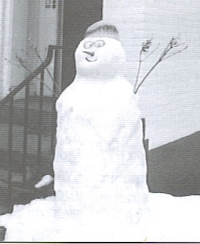
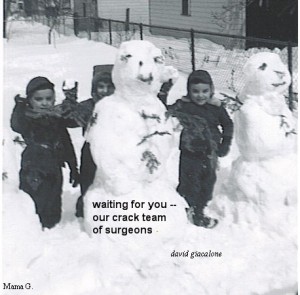
 Enough for now. I must salvage some daylight and perhaps scout for more snowmen. First, though I want to thank those who organized yesterday’s Winter Festival in Schenectady’s Central Park (see the
Enough for now. I must salvage some daylight and perhaps scout for more snowmen. First, though I want to thank those who organized yesterday’s Winter Festival in Schenectady’s Central Park (see the 



 Last Thanksgiving, I mentioned Arthur’s complaint to Mama G. She scoffed, pointing out that she always had to make three snowmen at a time. Being my mother’s son, and despite a lifetime not defending my older-twin brother, I immediately reminded her that Arthur and his knees are three decades older than she was the last time she made three snowmen. Then, weary just thinking of all that labor, the defense rested, point made and taken.
Last Thanksgiving, I mentioned Arthur’s complaint to Mama G. She scoffed, pointing out that she always had to make three snowmen at a time. Being my mother’s son, and despite a lifetime not defending my older-twin brother, I immediately reminded her that Arthur and his knees are three decades older than she was the last time she made three snowmen. Then, weary just thinking of all that labor, the defense rested, point made and taken. free, rare & pretty darn cool!
free, rare & pretty darn cool! 

 We may have no control over celestial events, but the free-viewing of important academic books is within the control of publishers and authors, and I hope Solove’s example is widely-followed. Thanks to Dan Solove for choosing access over potential profits.
We may have no control over celestial events, but the free-viewing of important academic books is within the control of publishers and authors, and I hope Solove’s example is widely-followed. Thanks to Dan Solove for choosing access over potential profits.

 We are still avoiding new lawyer-themed punditry here at f/k/a. But, this is Presidents’ Day, and our admiration for that lanky lawyer from Illinois, Abraham Lincoln, makes the Gang want to remind you of prior posting we’ve done about him and his attitudes toward lawyering, litigation, life, etc. So please take a look at:
We are still avoiding new lawyer-themed punditry here at f/k/a. But, this is Presidents’ Day, and our admiration for that lanky lawyer from Illinois, Abraham Lincoln, makes the Gang want to remind you of prior posting we’ve done about him and his attitudes toward lawyering, litigation, life, etc. So please take a look at:
 [
[
 In addition to four other pictures by Yu Chang, you’ll find many more antitdotes to wintry grays and whites in the new issue of Simply Haiku — including haiga images from
In addition to four other pictures by Yu Chang, you’ll find many more antitdotes to wintry grays and whites in the new issue of Simply Haiku — including haiga images from  Despite trying to avoid stressful online arguments lately, I don’t feel that I can in good conscience refer you to the Modern Haiga at Simply Haiku without raising an important issue concerning the essence of haiga excellence. Beyond my chronic complaint over the use of far too many “tell-em”/”
Despite trying to avoid stressful online arguments lately, I don’t feel that I can in good conscience refer you to the Modern Haiga at Simply Haiku without raising an important issue concerning the essence of haiga excellence. Beyond my chronic complaint over the use of far too many “tell-em”/” My introduction to modern haiga came through the intervention and inspiration of my friend Aurora Antonovic, who is the
My introduction to modern haiga came through the intervention and inspiration of my friend Aurora Antonovic, who is the 
 [
[ The premiere print edition of the
The premiere print edition of the  The first print issue of MagnaPoets has a gorgeous, glossy
The first print issue of MagnaPoets has a gorgeous, glossy 
 For the more intellectual and history-oriented flamingo buffs, we suggest the book “
For the more intellectual and history-oriented flamingo buffs, we suggest the book “ Kitsch collectors should click this link for
Kitsch collectors should click this link for 
 Or, perhaps this pair in flamingo pink
Or, perhaps this pair in flamingo pink 

 My contributions to the now-defunct
My contributions to the now-defunct 
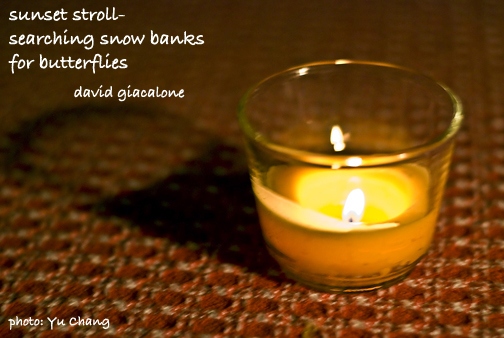







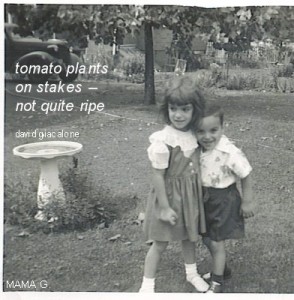







 another
another





 rain on
rain on



 Afterthought (9 PM; Feb. 13): An article in today’s New York Times has helped me understand that there are far worse things in life than dining alone on Valentine’s Day. See “
Afterthought (9 PM; Feb. 13): An article in today’s New York Times has helped me understand that there are far worse things in life than dining alone on Valentine’s Day. See “
 This might be a good time to remind husbands of Joshua Foer’s 2006 Valentine op/ed piece, “
This might be a good time to remind husbands of Joshua Foer’s 2006 Valentine op/ed piece, “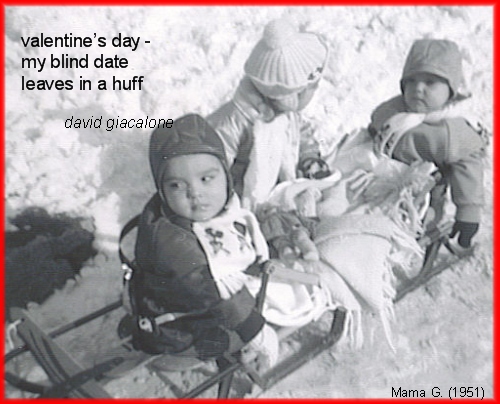

 Perhaps the legal experts at
Perhaps the legal experts at  By agreeing not to open on Mondays, and by trying to force other shops to close on Mondays, the “union” of barbers is really a cartel engaging in collective action that appears to violate the antitrust law.
By agreeing not to open on Mondays, and by trying to force other shops to close on Mondays, the “union” of barbers is really a cartel engaging in collective action that appears to violate the antitrust law.